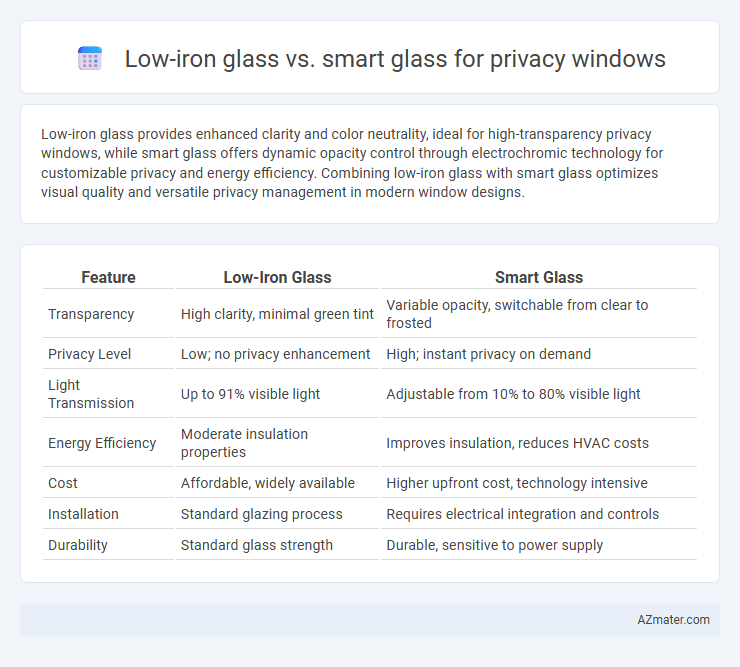Low-iron glass provides enhanced clarity and color neutrality, ideal for high-transparency privacy windows, while smart glass offers dynamic opacity control through electrochromic technology for customizable privacy and energy efficiency. Combining low-iron glass with smart glass optimizes visual quality and versatile privacy management in modern window designs.
Table of Comparison
| Feature | Low-Iron Glass | Smart Glass |
|---|---|---|
| Transparency | High clarity, minimal green tint | Variable opacity, switchable from clear to frosted |
| Privacy Level | Low; no privacy enhancement | High; instant privacy on demand |
| Light Transmission | Up to 91% visible light | Adjustable from 10% to 80% visible light |
| Energy Efficiency | Moderate insulation properties | Improves insulation, reduces HVAC costs |
| Cost | Affordable, widely available | Higher upfront cost, technology intensive |
| Installation | Standard glazing process | Requires electrical integration and controls |
| Durability | Standard glass strength | Durable, sensitive to power supply |
Introduction to Privacy Window Solutions
Low-iron glass and smart glass are leading materials for privacy window solutions in modern architecture. Low-iron glass offers high clarity and natural light transmission while minimizing green tint, enhancing visibility with subtle privacy through reflective coatings. Smart glass dynamically adjusts opacity with electric control, providing instant privacy on demand without sacrificing daylight or design aesthetics.
What is Low-Iron Glass?
Low-iron glass is a type of glass specifically designed with reduced iron content to enhance transparency and clarity, providing a near-colorless appearance ideal for privacy windows. Unlike standard glass that can have a greenish tint due to higher iron levels, low-iron glass offers better light transmittance and sharper views without distorting color perception. When used in privacy windows, low-iron glass enhances natural light while maintaining a clean, unobstructed aesthetic, distinguishing it from smart glass which uses electrochromic technology for adjustable opacity.
Defining Smart Glass Technology
Smart glass technology utilizes electrochromic, thermochromic, or liquid crystal layers to dynamically control light transmission and opacity, providing customizable privacy on demand. Low-iron glass enhances clarity and natural light by reducing iron content but lacks the adjustable privacy features inherent to smart glass systems. Smart glass integrates advanced materials and electronic controls, offering superior privacy solutions compared to static low-iron glass options.
Visual Clarity and Light Transmission Comparison
Low-iron glass offers superior visual clarity due to its reduced green tint, ensuring high light transmission typically around 91%, making it ideal for privacy windows that require maximum natural light without color distortion. Smart glass, by contrast, varies light transmission dynamically, ranging from approximately 1% in its opaque state to over 60% when clear, but may slightly compromise visual clarity due to embedded electrochromic or suspended particle layers. Choosing between low-iron and smart glass depends on the balance between consistent optical transparency and the ability to modulate privacy with adjustable light control.
Privacy Functionality: Low-Iron vs Smart Glass
Low-iron glass offers enhanced clarity but provides minimal privacy since it is transparent and does not alter visibility. Smart glass, utilizing electrochromic or thermochromic technology, significantly improves privacy by switching from transparent to opaque states on demand. This dynamic functionality makes smart glass the superior choice for privacy windows compared to static low-iron glass.
Energy Efficiency and Insulation Properties
Low-iron glass offers high clarity and enhanced solar control, contributing to better energy efficiency by reducing heat gain and improving natural lighting in privacy windows. Smart glass dynamically adjusts its tint in response to sunlight, optimizing insulation properties by controlling heat transfer and reducing reliance on heating or cooling systems. Both technologies enhance energy performance, but smart glass provides adaptable insulation, whereas low-iron glass excels in maximizing light transmission with stable thermal resistance.
Aesthetic and Design Flexibility
Low-iron glass offers exceptional clarity and brightness, enhancing aesthetic appeal by providing a crystal-clear view with minimal green tint, making it ideal for modern privacy windows where visual purity is paramount. Smart glass delivers dynamic design flexibility through its ability to switch opacity on demand, allowing seamless transitions between transparent and frosted states that adapt privacy levels without compromising style. Combining low-iron glass with smart technology creates a sophisticated privacy solution, balancing high visual quality with innovative, customizable control over light and privacy.
Cost Considerations and Long-term Value
Low-iron glass offers a clear, high-visibility option for privacy windows at a moderate initial cost, making it a budget-friendly choice for projects emphasizing aesthetic clarity. Smart glass, while more expensive upfront due to advanced technology enabling instant opacity control, delivers significant long-term value through energy savings and customizable privacy settings. Evaluating cost considerations with lifetime performance reveals smart glass as a superior investment when factoring in reduced energy bills and enhanced functionality over time.
Installation and Maintenance Differences
Low-iron glass offers a clear, color-neutral appearance for privacy windows but requires professional cutting and careful handling during installation to avoid chips and cracks, leading to longer setup times. Smart glass integrates electronic components for adjustable opacity, demanding specialized electrical installation and periodic maintenance to ensure consistent performance and functionality. Maintenance of low-iron glass typically involves standard cleaning, while smart glass requires additional care for its conductive layers and control systems to prevent damage and operational issues.
Choosing the Best Privacy Glass for Your Needs
Low-iron glass offers high clarity and natural light transmission, making it ideal for spaces where maintaining brightness is crucial while ensuring privacy. Smart glass provides dynamic opacity control through electrical activation, allowing users to switch between transparent and frosted states for customizable privacy on demand. Choosing the best privacy glass depends on factors like light requirements, energy efficiency, and privacy control preferences for your specific application.

Infographic: Low-iron glass vs Smart glass for Privacy window
 azmater.com
azmater.com